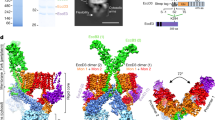Abstract
PHOSPHORYLATION of proteins catalysed by protein kinases is associated with central functions in growth and proliferation of the eukaryotic cell, and kinases are particularly important in the signal transduction pathways1,2. Enterobacterial protein kinases are structurally and functionally different from eukaryotic protein kinases3,4, and no prokaryotic kinase has so far been described implicating a direct role for this activity in virulence. Virulent Yersinia possess a common virulence plasmid that encodes a number of secreted proteins (Yops)5–7, of which YopH has protein-tyrosine phosphatase activity with a key function in the block of phagocytosis by the pathogen8–10. Here we report that the virulence plasmid of Yersinia pseudotuberculosis encodes a secreted protein kinase (YpkA) with extensive homology to eukaryotic Ser/Thr protein kinases3,11. Specific mutants of ypkA resulted in avirulent strains. Thus, YpkA is, to our knowledge, the first reported prokaryotic secreted protein kinase involved in pathogenicity, presumably by interfering with the signal transduction pathways of the target cell.
This is a preview of subscription content, access via your institution
Access options
Subscribe to this journal
Receive 51 print issues and online access
$199.00 per year
only $3.90 per issue
Buy this article
- Purchase on Springer Link
- Instant access to full article PDF
Prices may be subject to local taxes which are calculated during checkout
Similar content being viewed by others
References
Nurse, P. Nature 344, 503–508 (1990).
Pelech, S. L. & Sanghera, J. S. Trends biochem. Sci. 17, 233–238 (1992).
Hanks, S. K. Curr. Opinion struct. Biol. 1, 369–383 (1991).
Cozzone, A. J. A. Rev. Microbiol. 4, 97–125 (1988).
Bölin, I., Portnoy, D. A. & Wolf-Watz, H. Infect. Immun. 48, 234–240 (1985).
Cornells, G., Vanooteghem, J.-C. & Sluiters, C. Microbial Pathogen. 2, 367–379 (1987).
Straley, S. C. & Bowmer, W. S. Infect. Immun. 51, 445–454 (1986).
Rosqvist, R., Bölin, I. & Wolf-Watz, H. Infect. Immun. 56, 2139–2143 (1988).
Guan, K. L. & Dixon, J. E. Science 249, 553–556 (1990).
Clemens, J. C., Guan, K., Bliska, J. B., Falkow, S. & Dixon, J. E. Molec. Microbiol. 5, 2617–2620 (1991).
Hanks, S. K., Quinn, A. M. & Hunter, T. Science 241, 42–52 (1988).
Rosqvist, R., Forsberg, Å., Rimpiläinen, M., Bergman, T. & Wolf-Watz, H. Molec. Microbiol. 4, 657–667 (1990).
Leung, K. Y., Reisner, B. S. & Straley, S. C. Infect. Immun. 58, 3262–3271 (1991).
Rosqvist, R., Forsberg, Å. & Wolf-Watz, H. Infect. Immun. 59, 4562–4569 (1991).
Lindberg, R. A., Quinn, A. M. & Hunter, T. Trends biochem. Sci. 17, 114–119 (1992).
Cooper, J. A., Sefton, B. M. & Hunter, T. Meth. Enzym. 99, 387–402 (1983).
Bölin, I. & Wolf-Watz, H. Molec. Microbiol. 2, 237–245 (1988).
Rimpiläinen, M., Forsberg, Å & Wolf-Watz, H. J. Bact. 174, 3355–3363 (1992).
Forsberg, Å., Bölin, I., Norlander, L. & Wolf-Watz, H. Microbiol Pathogen. 2, 123–137 (1987).
Forsberg, Å., Viitanen, A.-M., Skurnik, M. & Wolf-Watz, H. Molec. Microbiol. 5, 977–986 (1991).
Author information
Authors and Affiliations
Rights and permissions
About this article
Cite this article
Galyov, E., Håkansson, S., Forsberg, Å. et al. A secreted protein kinase of Yersinia pseudotuberculosis is an indispensable virulence determinant. Nature 361, 730–732 (1993). https://doi.org/10.1038/361730a0
Received:
Accepted:
Issue Date:
DOI: https://doi.org/10.1038/361730a0
This article is cited by
-
The PPE2 protein of Mycobacterium tuberculosis translocates to host nucleus and inhibits nitric oxide production
Scientific Reports (2017)
-
Mechanisms of Yersinia YopO kinase substrate specificity
Scientific Reports (2017)
-
Yersinia effector YopO uses actin as bait to phosphorylate proteins that regulate actin polymerization
Nature Structural & Molecular Biology (2015)
-
Subversive bacteria reveal new tricks in their cytoskeleton-hijacking arsenal
Nature Structural & Molecular Biology (2015)
-
A serine/threonine phosphatase encoded by MG_207 of Mycoplasma genitalium is critical for its virulence
BMC Microbiology (2013)
Comments
By submitting a comment you agree to abide by our Terms and Community Guidelines. If you find something abusive or that does not comply with our terms or guidelines please flag it as inappropriate.



